Reserve Bank of Australia Annual Report – 2018 Our People
The Reserve Bank seeks to attract, develop and retain high-quality people, and to foster an environment where there is a strong focus on values and behaviour, and a clear understanding of the Bank's risk appetite. This is supported by the Bank's People and Culture Strategy, which focuses on leadership development, diversity and inclusion. In 2017/18, the proportion of women in management increased and the Bank created additional employment opportunities for Indigenous Australians and those seeking flexible work arrangements. The total number of employees declined slightly. The composition of the workforce changed, reflecting the completion of a number of large projects.
Workforce Profile
In June 2018, the Reserve Bank (excluding Note Printing Australia Limited) had 1,362 employees, of which 8 per cent worked part time. As such, the Bank's workforce comprised 1,327 full-time equivalent (FTE) employees. During 2017/18, there was a decrease in project resourcing as a number of large projects were completed, which was largely offset by an increase in staff to operate and support the new activities and services resulting from these projects. The overall number of employees is expected to decline in 2018/19 as further projects are completed.
During the year, the Reserve Bank hired 222 employees, of which 70 per cent were recruited on fixed-term contracts largely to support project-related work. The new recruits included information technology (IT) and project-related professionals. For non-project-related work, recruitment has taken place across all areas of the Bank. The graduate and internship programs continue to be an important recruitment channel for the Bank, particularly in the policy formulation and implementation areas. In 2017/18, these early career programs were supplemented by a number of mid-career hires.
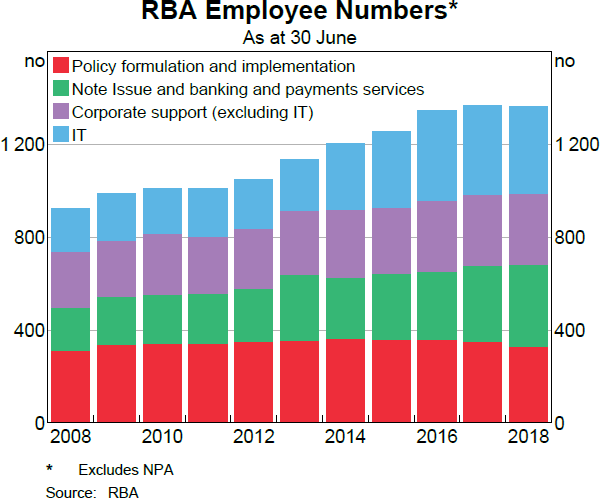
In the year to June 2018, the Reserve Bank hired 28 university graduates and 22 vacation-work interns. These graduates and interns work in the Bank's policy, business services and corporate support areas and hold degrees in economics, commerce, IT and other professional disciplines. The Bank's workforce diversity profile has remained relatively stable over recent years.
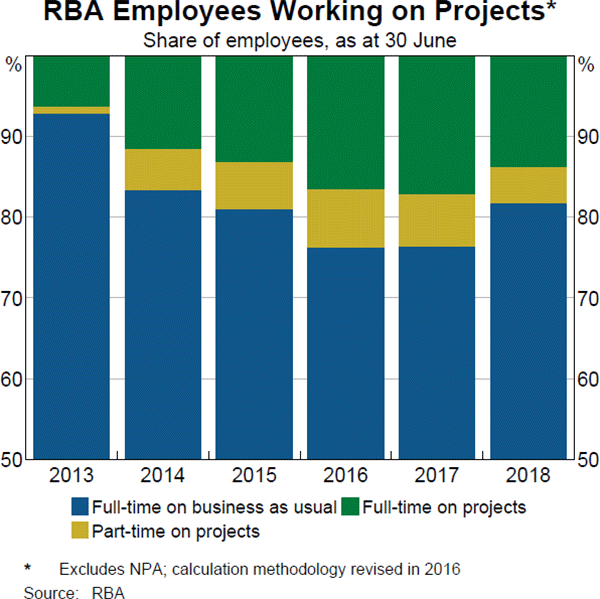
The average age of Reserve Bank employees is 39 years, with almost two-fifths of employees under the age of 35. This reflects the Bank's strong focus on early-career hires each year through its graduate, internship and traineeship programs. The median tenure of employees is five years. During 2017/18, around 11 per cent of employees left the Bank. Resignations and retirements accounted for almost two-thirds of these exits. Contract expiration accounted for one-third of exits, given the high level of project-related work under way.
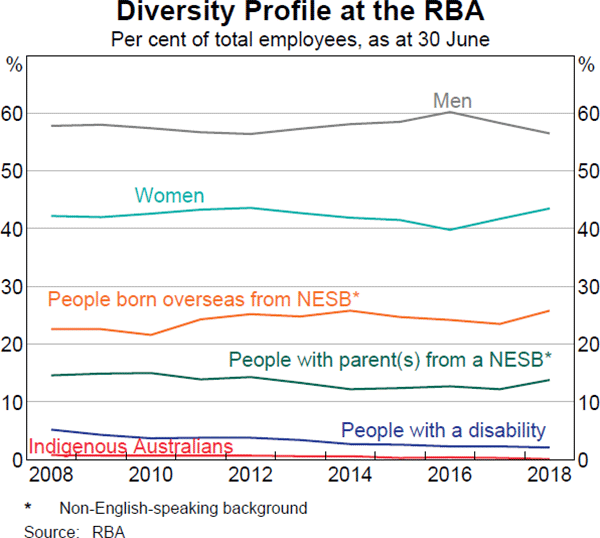
People and Culture
The Reserve Bank's core values, as set out in its Code of Conduct, help shape the Bank's culture and guide expectations and standards around workplace behaviour and professional conduct. The Bank's values are as follows.
1. Promotion of the public interest
We serve the public interest. We ensure that our efforts are directed to this objective, and not to serving our own interests or the interests of any other person or group.
2. Integrity
We are honest in our dealings with others within and outside the Bank. We are open and clear in our dealings with our colleagues. We take appropriate action if we are aware of others who are not acting properly.
3. Excellence
We strive for technical and professional excellence.
4. Intelligent inquiry
We think carefully about the work we do and how we undertake it. We encourage debate, ask questions and speak up when we have concerns.
5. Respect
We treat one another with respect and courtesy. We value one another's views and contributions.
There is a strong focus on these core values within the Reserve Bank, led by the Governor, and supported by the Bank's multi-year People and Culture Strategy. In 2017/18, the focus of this strategy remained to:
- identify aspects of the Bank's culture and work environment that are strengths, as well as areas that need improvement, and measure progress in making improvements
- develop a deep and diverse pool of well-trained potential leaders
- fully utilise the talents of the Bank's people
- foster an inclusive and flexible work environment.
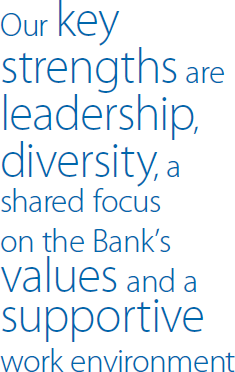
Steady progress in implementing the People and Culture Strategy continued to be made in 2017/18. In 2017, to support the first objective, the Reserve Bank undertook its third employee engagement survey. The survey is a useful tool for identifying our strengths as an organisation and opportunities for improvement. In the survey, employees reported a high level of engagement, consistent with the previous two surveys. Results also reflected the effectiveness of departmental and enterprise-wide action plans, particularly work aimed at improving the areas of empowerment and communication. The survey indicated that our key strengths are in the areas of leadership, diversity, a shared focus on the Bank's values among staff at all levels and providing a supportive work environment. Efforts will continue to address issues identified in this and previous employee engagement surveys, with a focus on improving collaboration, organisational change, decision-making, retention and career opportunities. Recent areas of focus have also included further encouragement for staff to speak up when they have a different opinion or a concern, and enhancing their understanding of appropriate risk-taking in pursuit of the Bank's objectives. A further survey will be conducted in around two years to assess progress and identify new opportunities.
The Reserve Bank continued its focus on leadership development, talent management and diversity and inclusion during the year in review. Following completion of the Bank's Executive Leadership Development Program and Empowering Leaders Development Program for future leaders, a new Engaging Leaders Program was introduced for people managers to build capability and confidence across the cohort in core leadership and people management.
The People and Culture Strategy also places emphasis on ensuring that the talents of employees are fully utilised and developed. On-the-job development opportunities are supplemented by formal training and professional development programs, including:
- the eight-week Internship Program, which provides high-performing university students work experience and training through the completion of an applied research project. This program is an important source of early-career professionals for the Reserve Bank's Graduate Development Program. In 2017/18, 22 interns joined the Bank
- the two-year Graduate Development Program, consisting of a range of tailored training programs to develop policymaking frameworks, effective business writing, critical thinking, presentation, communication and negotiation skills. A total of 63 graduates participated in the program in 2017/18
- training as required in technical, management and leadership skills, resilience and other general competencies, such as communication skills
- regular training in the Bank's compliance obligations, including in relation to work health and safety, mental health and wellbeing, fraud awareness and anti-money laundering/counter-terrorism financing.
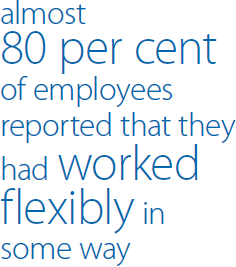
Development opportunities are provided to employees by facilitating internal rotation programs between different areas of the Reserve Bank and external secondments. The Bank also hosts secondees from external institutions to foster corporate networks and share understanding of best practice. In 2017/18, the breadth of secondment activities increased, involving a wide range of Australian institutions, including the Australian Bureau of Statistics, the Australian Competition and Consumer Commission, the Australian Prudential Regulation Authority, the Australian Treasury and the Commonwealth Department of the Prime Minister and Cabinet, as well as a range of international institutions (see the chapter on ‘International Financial Cooperation’ for details).
The Reserve Bank encourages employees to develop their skills continually and provides financial support to employees for part-time study in disciplines related to their work, with 71 employees benefiting from this support during 2017/18. In addition, the Bank provided support to nine employees undertaking full-time postgraduate study at universities in Australia and overseas during this period.
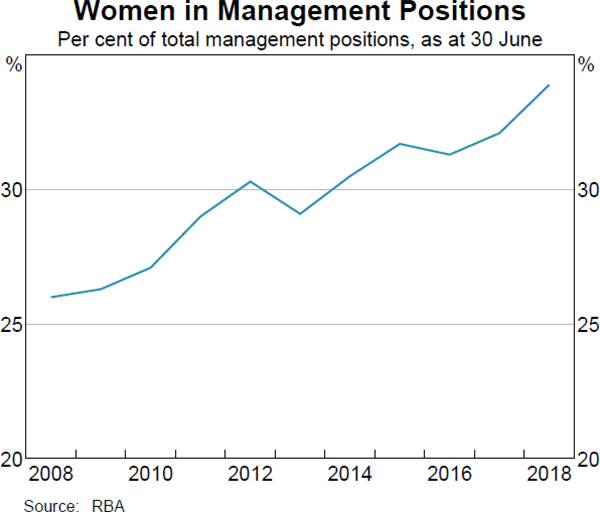
The People and Culture Strategy actively promotes an inclusive work environment. The Reserve Bank's Diversity and Inclusion Council and Employee Resource Groups (ERGs) continued to pursue activities and practices that support the Bank's Diversity and Inclusion Plan. The Bank continues to support flexible work practices, including part-time work and job-share arrangements. The Bank also enables flexible ways of working full time, by supporting changes in work patterns or location, including altering start or finish times, working compressed work weeks, and working from home or other locations. In the 2017 employee engagement survey, almost 80 per cent of employees reported that they had worked flexibly in some way in the preceding 12 months. In 2017/18, an additional flexibility initiative, the MOVE program (Managerial roles Offering Variable and flexible Employment), was launched. The program seeks to attract candidates with skills and experience that are important to the Bank, and to tailor roles to meet the flexibility candidates need to be successful and engaged in meaningful work. So far, two roles at the senior management level have been filled through the program. Training and resources were also offered to managers to ensure they are equipped to manage flexible work requests.
The overall representation of women in management at the Reserve Bank was 34 per cent in June 2018, up from 32 per cent in the previous year. During the year, 50 per cent of managerial vacancies were filled by women, and 80 per cent of roles at the senior manager level and above were filled by women. The Bank has a gender target of 35 per cent of management positions to be filled by women by 2020, with a longer-term aim of 50 per cent. In support of the gender target, there is a strong focus on talent management at the Bank, including succession and development planning for both women and men, and measures to ensure diversity of candidates in all selection processes.
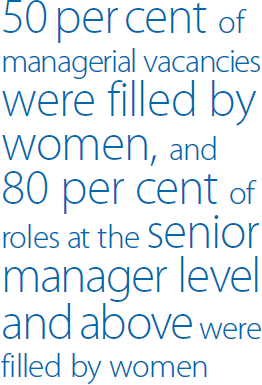
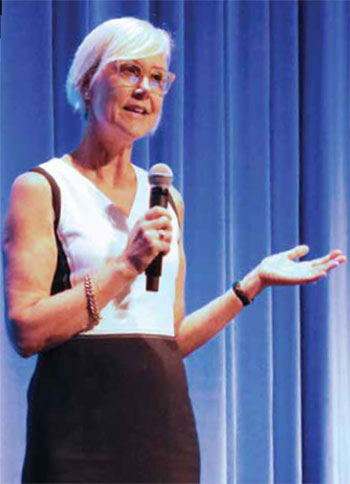
The Reserve Bank actively works to promote economics, finance, mathematics and IT as career options for women. The Bank's Public Access & Education team is dedicated to providing learning experiences and information to schools, universities and educators about the economy and the role of Australia's central bank (see the chapter on ‘Community Engagement’ for details). The Bank awarded its second annual scholarship for teachers in 2017 to help promote and support the study of economics in schools, particularly by females. The first scholarship recipient worked closely with the Bank during the year in review on a research project examining factors that may encourage the participation of female students in economics at secondary and tertiary levels.
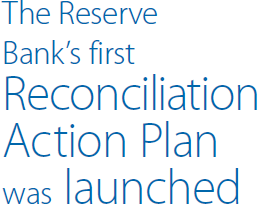
To promote the inclusion of Indigenous Australians in the workplace, the Reserve Bank's Reconciliation Action Plan (RAP) Working Group launched the Bank's first RAP. A major initiative was the installation of a second flagpole at the Reserve Bank's Head Office to permanently display the Aboriginal flag as a symbol of the Bank's commitment to reconciliation. A flag-raising ceremony, accompanied by an Acknowledgement of Country, was conducted during National Reconciliation Week in late May 2018. Flag stands displaying both the Australian and Aboriginal flags have also been installed at the Bank's other locations around Australia. An Acknowledgement of Country is also now incorporated into major Bank events.
The Reserve Bank continued to fund an internship for Indigenous Australian university students, with four recipients in 2017/18. The internship was facilitated by CareerTrackers, a not-for-profit agency that works with organisations to provide work experience, networking and professional development opportunities for Indigenous Australian university students. The internship involved vacation work at the Bank as well as professional development training. During the year, the Bank refocused its traineeship program on providing work experience and a nationally recognised qualification to Indigenous Australians. Four trainees were involved in the first year of the program. The Bank also welcomed two tertiary students with a disability through the Australian Network on Disability's ‘Stepping Into’ internship program and continues to provide long-term employment for individuals with intellectual disabilities through the JobSupport program.

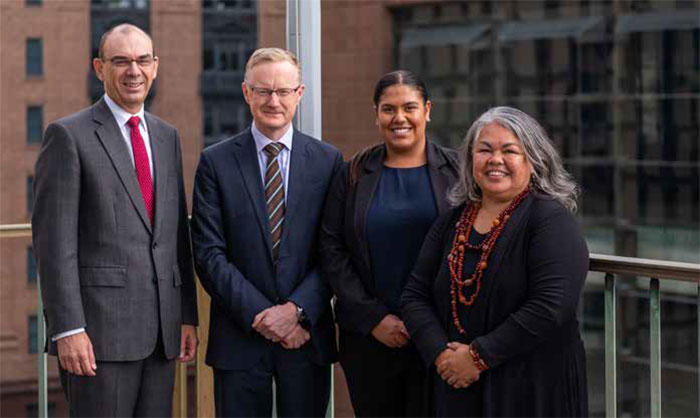
The Reserve Bank raised employees' awareness and involvement in diversity and work health and safety matters by supporting staff participation in external events and hosting guests at the Bank to speak on diversity, inclusion and health-related topics. Diversity events included speakers on gender and race matters, along with events to mark NAIDOC week, Reconciliation Week, Harmony Day, Wear It Purple Day, International Women's Day and Global Accessibility Awareness Day. In addition, the Bank continued to raise awareness about mental health in the workplace, including through R U OK?Day activities, and other initiatives from its newly developed mental health strategy to support the prevention of workplace mental health issues.
Remuneration
Remuneration packages for Reserve Bank staff are designed to attract and engage high-calibre employees. In line with the Bank's commitment to openness and transparency, the distribution of remuneration paid to Bank executives and other senior employees on a cash basis is set out in the tables below. The provision of this information is consistent with similar information provided by other Commonwealth entities.
The Reserve Bank's Workplace Agreement provides for a performance-based salary increase distributed from a pool equivalent to 2 per cent of salaries. The agreement makes available an additional lump-sum performance-based payment distributed from a pool of 2 per cent of salaries.
| Remuneration band | Number | Reportable salary1 | Superannuation2 | Lump sum3 | Total |
|---|---|---|---|---|---|
| $0 to $200,000 | 4 | 137,928 | 21,429 | – | 159,357 |
| $200,001 to $225,000 | 1 | 184,998 | 29,250 | – | 214,248 |
| $250,001 to $275,000 | 1 | 222,968 | 35,412 | 1,295 | 259,675 |
| $275,001 to $300,000 | 1 | 249,108 | 39,111 | 5,036 | 293,255 |
| $300,001 to $325,000 | 1 | 267,891 | 43,667 | 2,290 | 313,848 |
| $325,001 to $350,000 | 9 | 287,544 | 46,806 | 4,607 | 338,957 |
| $350,001 to $375,000 | 6 | 308,203 | 46,595 | 5,594 | 360,392 |
| $375,001 to $400,000 | 3 | 322,525 | 52,117 | 5,572 | 380,214 |
| $400,001 to $425,000 | 2 | 348,154 | 57,630 | 6,833 | 412,617 |
| $425,001 to $450,000 | 1 | 370,676 | 61,632 | 6,567 | 438,875 |
| $450,001 to $475,000 | 3 | 385,767 | 65,004 | 4,204 | 454,975 |
| $475,001 to $500,000 | 3 | 405,615 | 69,111 | 6,125 | 480,851 |
| $500,001 to $525,000 | 3 | 437,561 | 74,266 | 8,495 | 520,322 |
| $550,001 to $575,000 | 2 | 476,679 | 82,109 | 8,261 | 567,049 |
| $575,001 to $600,000 | 1 | 486,739 | 82,735 | 6,260 | 575,734 |
| $600,001 to $625,000 | 1 | 521,582 | 89,520 | 9,540 | 620,642 |
| $625,001 to $650,000 | 1 | 542,080 | 92,807 | 14,483 | 649,370 |
| $750,001 to $775,000 | 1 | 679,000 | 85,963 | – | 764,963 |
| $1,000,001 to $1,025,000 | 1 | 903,418 | 114,617 | – | 1,018,035 |
| Total | 45 | ||||
|
(a) Includes total remuneration earned in Australia during the reporting period by executives at desk (or on parental or annual leave) as at 30 June 2018; each row shows an average figure based on the number of employees within each remuneration band based on total remuneration earned on a cash basis; an executive for the purpose of this table is anyone holding a position of Deputy Head of Department (or equivalent) or above Source: RBA Notes
|
|||||
| Remuneration band | Number | Reportable salary1 | Superannuation2 | Lump sum3 | Total |
|---|---|---|---|---|---|
| $200,001 to $225,000 | 66 | 178,029 | 29,733 | 3,368 | 211,130 |
| $225,001 to $250,000 | 37 | 198,880 | 33,940 | 3,570 | 236,390 |
| $250,001 to $275,000 | 23 | 221,398 | 36,354 | 3,721 | 261,473 |
| $275,001 to $300,000 | 8 | 240,153 | 39,608 | 5,564 | 285,325 |
| $300,001 to $325,000 | 6 | 261,503 | 42,383 | 4,292 | 308,178 |
| Total | 140 | ||||
|
(a) Includes total remuneration earned in Australia during the reporting period by other senior employees at desk (or on parental or annual leave) as at 30 June 2018; each row shows an average figure based on the number of employees within each remuneration band based on total remuneration earned on a cash basis. Source: RBA Notes
|
|||||